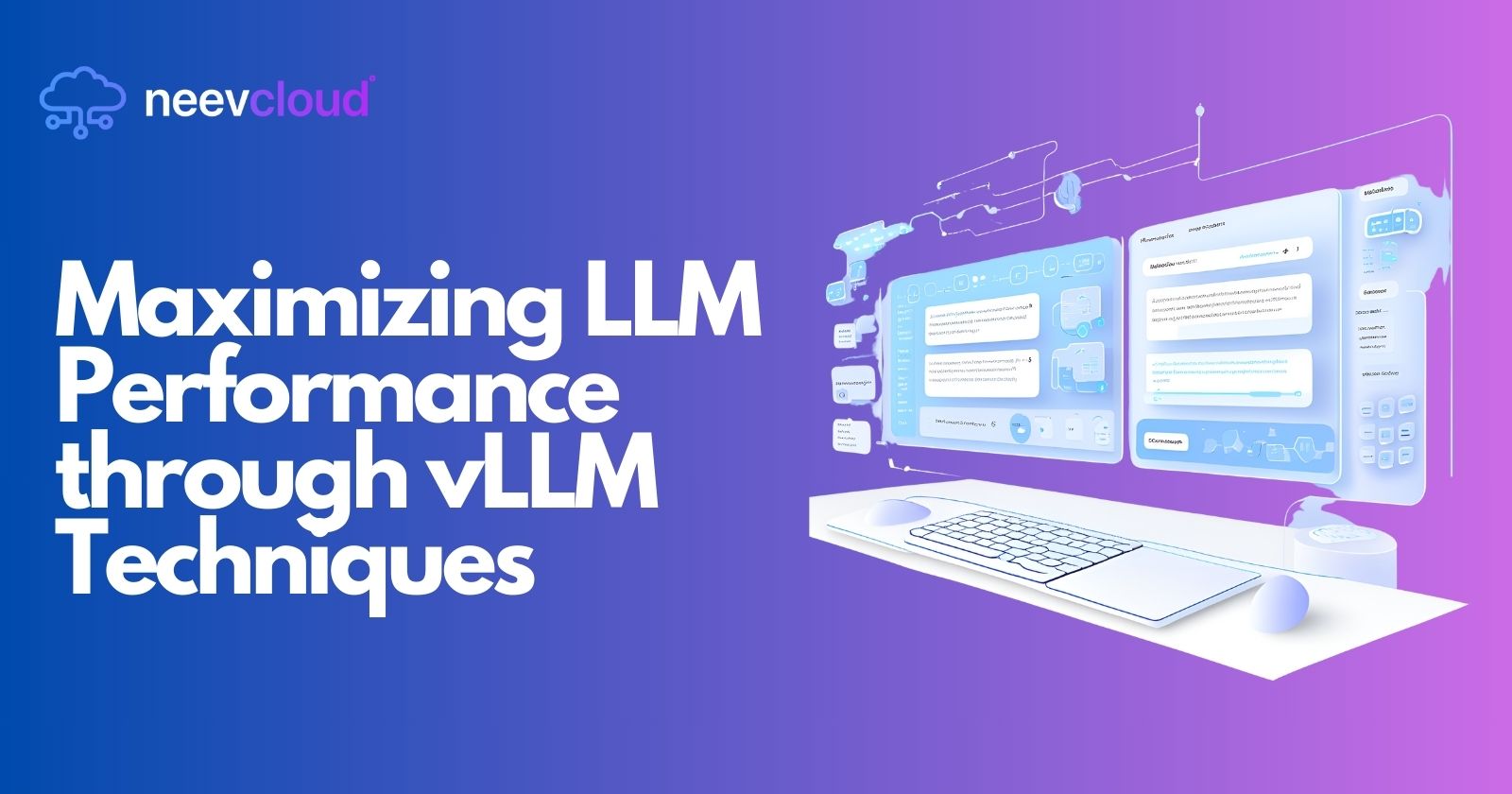Maximizing LLM Performance through vLLM Techniques
 Tanvi Ausare
Tanvi Ausare
In the realm of artificial intelligence, the rising prominence of large language models (LLMs) has created unprecedented opportunities for innovation across industries. However, the rapid expansion in model size and complexity presents unique challenges related to scalability, latency, and resource utilization. Virtualized Large Language Models (vLLM) emerge as a compelling solution, enabling organizations to maximize throughput while optimizing hardware and energy efficiency.
This article explores the concept of vLLM, its benefits, and its role in the AI Cloud and AI Datacenter ecosystems.
What is vLLM?
vLLM is an advanced framework designed to increase the efficiency of LLM deployment by improving memory management, parallelism, and hardware utilization. It virtualizes memory usage, ensuring that GPU or TPU resources are utilized more effectively.
Key Characteristics of vLLM:
Optimized Memory Allocation: Dynamically manages memory across GPUs to prevent wastage and reduce bottlenecks.
Fine-grained Parallelism: Enhances task scheduling, enabling multiple users to interact with the same model simultaneously.
Resource Sharing: Allows partitioning of LLMs to serve diverse workloads without requiring complete duplication of models.
High Throughput: Processes more queries per second by reducing overheads associated with traditional LLM architectures.
The Need for vLLM in LLM Workloads
Traditional LLM deployment faces significant limitations:
High Resource Consumption: LLMs demand extensive computational and memory resources, leading to inefficiencies in shared environments.
Latency Issues: Without optimized management, query processing can be slow, reducing real-time application feasibility.
Scalability Challenges: Scaling LLMs for multiple users or applications requires costly duplication or reconfiguration.
vLLM directly addresses these pain points by offering an architecture that balances performance and resource efficiency.
Benefits of vLLM in AI Cloud and AI Datacenter Environments
1. Improved Scalability
Supports multiple users and workloads without duplicating the entire LLM.
Scales across distributed GPU environments within AI Clouds seamlessly.
2. Enhanced Throughput
Reduces latency for real-time applications.
Increases queries processed per second by optimizing memory and compute utilization.
3. Cost Efficiency
Consolidates resource usage, reducing the need for additional hardware.
Lowers energy consumption in AI Datacenters by minimizing idle cycles.
4. Seamless Integration
Compatible with popular LLM frameworks like GPT, LLaMA, and PaLM.
Leverages cloud-native tools to integrate with existing AI workflows.
5. Sustainability
Promotes greener AI operations by optimizing energy use.
Reduces the carbon footprint of large-scale LLM deployments.
How vLLM Works
1. Memory Virtualization
Dynamically allocates memory blocks across multiple GPUs or TPUs.
Uses techniques like lazy loading to minimize memory overhead.
2. Efficient Query Routing
Implements smart scheduling algorithms to route queries to the most available resources.
Ensures load balancing across AI Datacenters.
3. Model Partitioning
Splits large models into smaller segments that can run independently.
Allows simultaneous inference across different workloads.
4. Dynamic Resource Scaling
Adjusts compute resources based on real-time demand.
Prevents underutilization during off-peak times.
Applications of vLLM
1. Real-time Conversational AI
Powers chatbots and virtual assistants with instant response times.
Handles concurrent queries without sacrificing accuracy.
2. Enterprise Knowledge Management
Supports large-scale document summarization and search tasks.
Optimized for structured and unstructured data processing.
3. Content Generation
Enables rapid content creation for media, marketing, and e-commerce.
Reduces delays in generating personalized outputs.
4. Healthcare and Diagnostics
Accelerates medical report summarization and query resolution.
Ensures secure and efficient processing of sensitive data.
Key Metrics to Measure vLLM Performance
Throughput (Queries Per Second): Measures how efficiently the system processes requests.
Latency (Response Time): Tracks the time taken to provide outputs for user queries.
Memory Utilization: Analyzes how effectively GPU or TPU memory is being used.
Scalability: Evaluates the system’s ability to handle increasing workloads.
Energy Efficiency: Quantifies power consumption relative to throughput.
Implementing vLLM in AI Cloud
1. Choosing the Right Infrastructure
Opt for cloud platforms with high-performance GPUs, such as NVIDIA H100 or A100.
Ensure compatibility with containerization tools like Kubernetes for streamlined deployment.
2. Utilizing Pre-trained Models
Use pre-trained LLMs available in the cloud ecosystem to accelerate setup.
Leverage fine-tuning to customize models for specific applications.
3. Integration with AI Datacenters
Deploy vLLM in AI Datacenters to benefit from centralized resource management.
Implement monitoring tools to track performance metrics in real time.
4. Optimization with Tools and Frameworks
Use libraries like DeepSpeed or Megatron-LM to enhance LLM efficiency.
Employ profiling tools to identify and eliminate bottlenecks in vLLM workflows.
Future of vLLM in Large Language Models
Trends Driving Adoption:
Growing Demand for Real-time AI: Industries like gaming, healthcare, and finance need instant AI responses.
Focus on Cost and Energy Efficiency: AI Datacenters are under pressure to optimize operations.
Proliferation of LLM Use Cases: As LLMs integrate into diverse domains, efficient deployment becomes crucial.
Expected Developments:
Hybrid vLLM Architectures: Combining on-premise and cloud environments for greater flexibility.
Advanced Load Balancing Algorithms: Further reducing latency and increasing throughput.
Integration with Edge AI: Bringing vLLM benefits closer to end-users for ultra-low latency applications.
Conclusion
vLLM is revolutionizing how organizations deploy and utilize large language models. By enhancing throughput, optimizing resource usage, and enabling scalable architectures, vLLM is paving the way for the next generation of AI-driven innovations.
For enterprises and developers looking to harness the power of LLMs, integrating vLLM into AI Cloud and AI Datacenter workflows represents a strategic move toward performance, cost efficiency, and sustainability.
By embracing vLLM, businesses can unlock the full potential of AI while staying ahead in an increasingly competitive landscape.
Subscribe to my newsletter
Read articles from Tanvi Ausare directly inside your inbox. Subscribe to the newsletter, and don't miss out.
Written by
